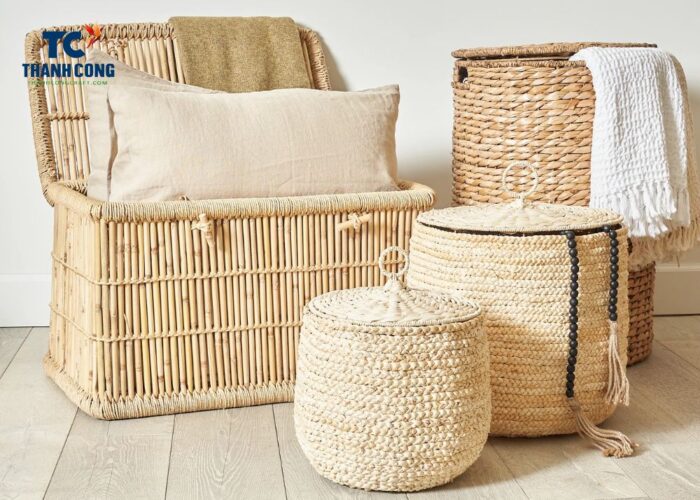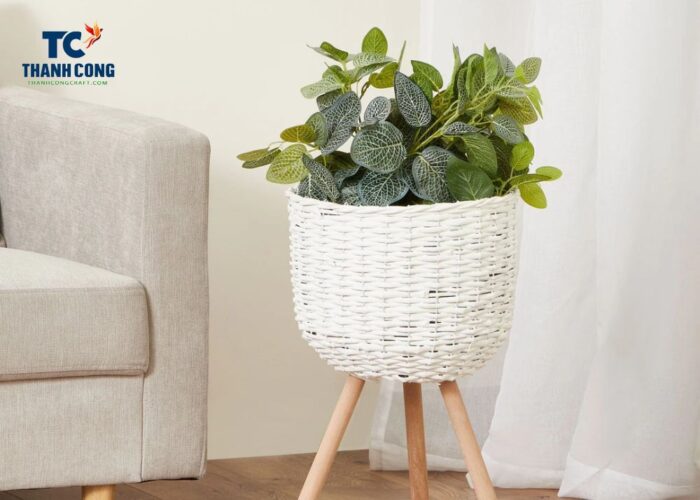Seagrass and rattan are two types of materials commonly used for making furniture items such as chairs, tables, baskets, lamps, etc. Seagrass vs rattan still have many differences in terms of characteristics, applications, sustainability, and cost. This article will introduce some key differences between seagrass and rattan.
Contents [hide]
1. Are Seagrass and Rattan The Same?
Seagrass and rattan are not the same. Seagrass refers to a type of grass that grows in coastal or riverside areas with brackish water, while rattan is a climbing plant belonging to subfamily Calamoideae, with a dense, flexible but light stem.
While both seagrass and rattan can be used in various industries, they are distinct materials with different characteristics.
Both of these materials are natural, flexible plants commonly found in Vietnam and the Southeast Asia region. They are also eco-friendly and biodegradable, making them environmentally sustainable choices. In the production of handicrafts, both rattan and seagrass are categorized as “wicker” materials and need to be dried before the weaving process commences.

Both rattan and seagrass exhibit good color fastness, allowing for dyeing, painting, and color-washing to create visually appealing products for decorative purposes. However, it’s important to note that if these items are exposed to a humid environment, they may experience fading over time. Therefore, they require careful use and preservation to ensure a longer lifespan.
With their earthy tones and woven textures, rattan and seagrass have been extensively utilized in Vietnam to manufacture a vast array of wholesalers. These items effortlessly add a touch of charm to any space, providing a delightful aesthetic appeal.
2. Difference between Seagrass and Rattan
While rattan and seagrass share some similarities as plant-derived materials, there are significant differences that distinguish them from each other.
Natural Structure:
Rattan consists of rigid canes that require processing to obtain intermediate products like rattan core and rattan peel. These components are then used to create wholesale home accents. On the other hand, seagrass has thin and pliable stems that are easily harvested and used directly for crafting.
Weaving Styles:
Due to its supple nature, woven seagrass allows for a wide range of weaving styles and patterns. In some cases, seagrass products may require additional support from metal frames for added sturdiness. Rattan, on the other hand, offers fewer weaving options, and not all rattan products require the support of a metal frame.
Hardness:
Rattan is generally sturdier than seagrass, allowing for weaving without the need for iron frames. However, rattan can become more brittle, especially when using split rattan core strands. Rattan can break under strong force or prolonged exposure to rain and sun. Seagrass is also susceptible to bursting, especially in high humidity conditions. Iron frames are commonly used with seagrass products to enhance strength and shape.

Resistance to Mold:
Both seagrass and rattan are prone to mold growth when exposed to excessive humidity. However, seagrass is more susceptible, while rattan has a lower level of susceptibility.
Resistance to Pest Attack:
Rattan canes, with their high starch content, are more susceptible to pest and insect attacks compared to seagrass. Special treatments such as oil-curing are required to remove starch and protect rattan during the processing stage. Seagrass, on the other hand, is generally not affected by insects.
Applications:
Rattan finds more extensive application in furniture production and outdoor homewares such as tables, chairs, and doors. Rattan cores and peels are often used to create wholesale home accents like baskets, planters, and lampshades for indoor use. Seagrass, being softer, is less commonly used in furniture production but is popular for crafting wholesale home accents such as baskets, indoor planters, trays, and lights.
3. What are seagrass and rattan used for?
Seagrass and rattan are used in various applications in the world of interior design and crafts. Here are some common uses for seagrass and rattan:
3.1 Seagrass and rattan Furniture
The product Seagrass and rattan furniture includes furniture items made from seagrass and rattan fibers, two natural materials that bring a natural and modern touch to the living space.
Seagrass rattan Furniture from seagrass and rattan natural products include chairs, benches, sofas, beds and bed frames. With seagrass, rattan fibers skillfully and carefully woven into spider web structures, furniture from seagrass and rattan creates a natural and outstanding beauty. Furniture from seagrass rattan can make the living space more spacious and airy. They are suitable for living rooms, bedrooms or any space in the house with interior styles from classic to modern.
3.2 Handicrafts
Rattan and seagrass, both natural and sustainable materials, are widely utilized in the production of handicraft items. These materials lend themselves well to various crafts, allowing artisans to create beautiful and functional pieces such as: seagrass basket, rattan basket, Planter seagrass Basket, seagrass Handbag…
Handicrafts made from seagrass and rattan not only showcase the natural beauty of the materials but also promote sustainability and support local artisan communities. By incorporating these environmentally friendly products into our homes, we can appreciate the craftsmanship while contributing to a greener and more socially responsible future.
3.3 Construction
Seagrass and rattan are not only versatile materials for handicrafts, but they can also be used in the construction industry. These natural resources offer a range of benefits and are increasingly being recognized as sustainable alternatives to traditional building materials. Seagrass can play a significant role in coastal and marine construction projects. Seagrass beds act as a natural buffer against erosion by stabilizing sediments and reducing wave energy.
Rattan, with its lightweight and flexible properties, can be utilized in various construction applications. Rattan can be woven or bent into shape to create fences, trellises, garden arches, and other decorative elements. These structures provide support for climbing plants, effectively adding a natural touch to gardens and outdoor spaces.
4. Conclusion
In conclusion, while rattan and seagrass are both excellent natural materials, they differ in their sources, appearance, durability, and comfort. Rattan offers a solid, textured look with excellent strength and versatility, while seagrass provides a softer, refined appearance.
Consider your specific needs and preferences when choosing between these two materials, and it will help you select the right furniture or decorative items for your space.
If you have any further questions, please don’t hesitate to contact Thanhcongcraft email at info@thanhcongcraft.com or message us at WhatsApp: +84967485411. Hope to serve you soon! Best regard!


